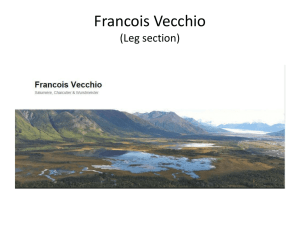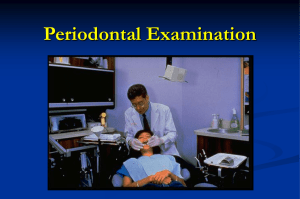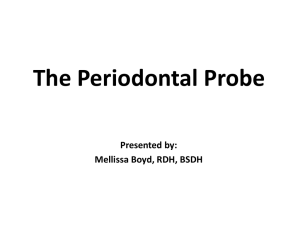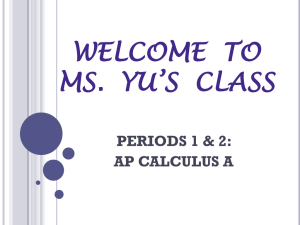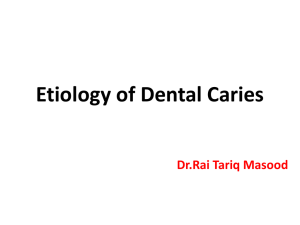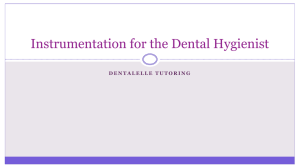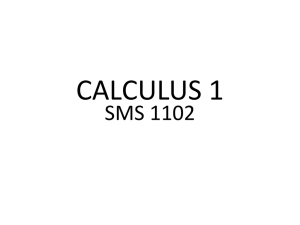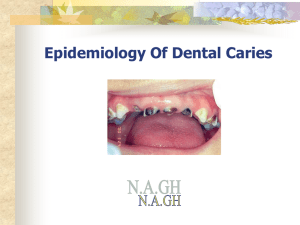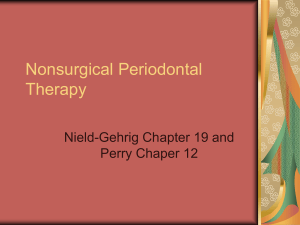Assessment Instruments Explorers and Probes
advertisement
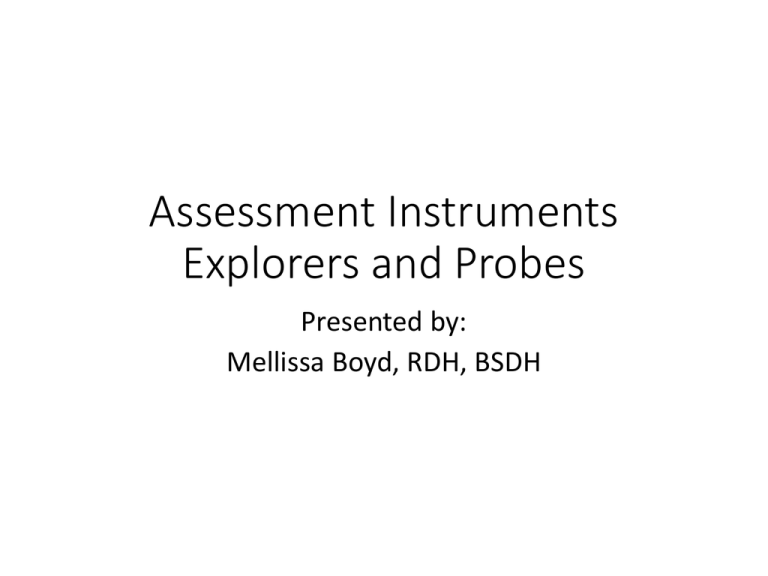
Assessment Instruments Explorers and Probes Presented by: Mellissa Boyd, RDH, BSDH Objectives • Recognize the different types of assessment instruments and their applications in patient care • Describe the fundamental applications of the 2 explorers found in the Chatt State Instrument Kits • Explain the design features of an explorer • Indentify the parts of the explorer shank Objectives • Describe what is meant by “tactile sensitivity” • Explain the design features of a calibrated periodontal probe • Discuss the fundamental applications of a calibrated periodontal probe Instrument Classification Assessment • Determine oral status and needs of patient • Health? • Disease? • Consists of several steps • • • • • Review MDHX Radiographs Head/Neck Cancer Exam Dentition Examination* Comprehensive Periodontal Examination* *Explorers and Probes used for Dentition exam and CPE Periodontal Exam Calculus 101 Plaque-Biofilm Calculus http://www.edwardbyrne.com/plaque.htm Dentition Exam ? Oral Cancer Screening Periodontal Probe Design Features • Working‐End – Blunt – Rod‐shaped • Cross‐section – Round – Rectangular • Types – Calibrated – Furcation Periodontal Probe Design Features • Working-End • Blunt • Rod-shaped • Cross-section • Round • Rectangular • Types • Calibrated • Furcation Purpose • Used in comprehensive periodontal exam or PSR • Measurement – Sulcus/pocket depths – Bleeding – Exudate – Recession – Oral lesions Periodontal Probe •Determine health of periodontal tissues Williams Probe • What are the mm markings on a Williams Probe? UNC 12 • What are the mm markings on the UNC 12 probe? UNC 15 Marquis Probe WHO probe (PSR) Probe Depth • What is the PD indicated in the picture? Sulcus vs. Pocket • Sulcus • Space between free gingiva and tooth • 1-3mm • Pocket • Sulcus deepened because of disease • 4mm+ • Gingival vs. Periodontal Probing Depths • Entire sulcus probed • Six sites recorded per tooth • 3 buccal/facial • 3 lingual • Record deepest reading per site • Depth rounded up to nearest mm Bleeding on Probing Explorer Design Features • Fine wire-like working-end • Flexible shank • Circular in cross-section • Straight or curved shanks • Paired or unpaired working ends Working-End • 1-2mm length used • Often referred to as “tip 1/3” • Calculus detection • Side of tip 1/3 • EXD 11/12 • Caries detection • Point of tip 1/3 • #23 Shepherd Hook “Tip 1/3” Shank Functional shank • Functional Shank • Long , complex • Begins below working end • Extends to last bend in shank nearest handle • Terminal Shank (lower) • Part of functional shank nearest to working-end Terminal shank Calculus Detection EXD 11/12 • Long, complex shank Curved • Shorter, slightly curved shank Calculus Detection Pigtail/Cowhorn • Extremely curved terminal shank Orban-type • Straight terminal shank Explorer Applications Detection • Texture of tooth/root surfaces • Calculus • Caries • Faulty restorations • Overhangs Tactile Sensitivity • Feel vibrations transferred from instrument tip, through shank, to handle • Learned ability • Accomplished by using very light grasp and lots of PRACTICE!! Examples of Tactile Sensations • Catching on overcontoured restorations • Dropping into a hole (carious lesions) • Bouncing over an elevated deposit • Feeling roughness Calculus Detection Three Types of Formation Supragingival Calculus • Coronal to GM • Rough, chalky white, beige, stained • Visual detection • Dry with air or cotton 2x2 Subgingival Calculus • Apical to GM • Located in sulcus or pocket • Tactile feeling only • May show in x-ray • Brown or Black Explorer Applications Evaluation • Completed treatment • Calculus removal • Restoration margins Caries Detection Shepherd Hook ( # 23) Straight Caries 101 Visible Caries • Obvious, frank, open lesions • Chalky, white, gray, brown, black in color • May retain food • Shallow lesions • Light pressure • Feels soft, tacky, leather-like Do NOT explore large, frank lesions! Caries Pit & Fissure Caries • Catch/stickiness when tracing fissure with light pressure Smooth Surface Caries • Visually check for discoloration • May feel rough or soft Caries Root Surface Caries • Develop on exposed cementum • Feel explorer “dip” in/out • May feel rough or leathery Recurrent Caries • Restoration margins • Feel explorer “dip” or catch along margin


